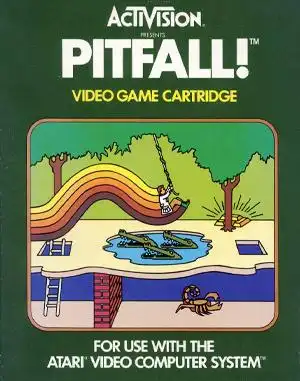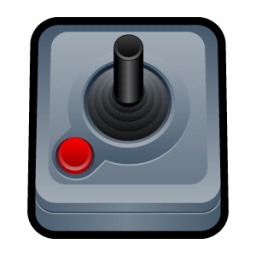Pitfall!: Reliving the Atari 2600's Iconic Jungle Adventure
Remember the thrill of swinging on a vine, leaping over crocodiles, and dodging rolling logs, all rendered in glorious, blocky Atari 2600 graphics? If you were gaming in the early 1980s, chances are you remember Pitfall!. This groundbreaking title from Activision wasn't just a game; it was an adventure that captured the imagination of a generation and set a new standard for home console gaming.
Released in 1982, Pitfall! put players in the boots of Pitfall Harry, an explorer on a quest for treasure deep within a perilous jungle. Unlike many games of its time, which were often simple score chases or single-screen affairs, Pitfall! offered a sprawling (for the era) environment with 255 screens to navigate within a strict 20-minute time limit.
The Jungle Awaits: What Was Pitfall! Gameplay Like?
Playing Pitfall! required quick reflexes and a touch of strategy. Harry could run, jump, climb ladders, and, most famously, swing on vines. The goal was to grab as much treasure as possible – gold bars, silver bars, and diamond rings – scattered across the screens, while avoiding a myriad of deadly hazards.
The jungle was unforgiving:
- Open Pits: Fall in, lose a life. Simple, brutal.
- Rolling Logs: Required precise timing to jump over.
- Quicksand: Sink slowly, requiring a quick jump out.
- Alligators: Crossing them meant timing your steps on their heads just right.
- Snakes & Scorpions: Touch them and lose points or a life.
- Fire Pits: Another hazard demanding careful jumps.
- Swinging Vines: The iconic way to cross gaps, requiring a well-timed jump on and off.
Navigating the 255 screens wasn't random; they followed a specific pattern, allowing dedicated players to memorize routes for optimal treasure collection. With only three lives to start, every mistake counted!
Behind the Pixels: The David Crane Story
Much of Pitfall!'s brilliance can be attributed to its designer, David Crane. After leaving Atari, where he felt developers weren't getting the recognition they deserved, he became one of the co-founders of Activision, the first third-party video game developer.
Crane's philosophy was to push the limits of the Atari 2600. He started by focusing on creating realistic character animation, which wasn't common then. This led to the idea of a character running, and a jungle setting seemed a natural fit, partly inspired by the adventurous spirit of films like "Raiders of the Lost Ark."
The core concept for the game reportedly took Crane only about 10 minutes to design. However, turning that concept into a playable game on the Atari 2600's limited 4KB cartridge required around 1000 hours of painstaking programming and optimization. The procedural generation of the 255 screens from a much smaller dataset was a technical marvel for the time. Crane even adjusted jump controls multiple times based on feedback to make the gameplay feel just right.
Jumping Across Platforms: Releases and Ports
Pitfall! first graced the Atari 2600 in September 1982 and quickly became a smash hit. Its success led to ports on numerous other systems in the following years, including:
- Intellivision
- ColecoVision
- Atari 5200
- Commodore 64
- MSX
- and more!
While the Atari 2600 version remains the most iconic, some ports, like the ColecoVision version, attempted to enhance the graphics, though not always fully utilizing the hardware's potential. Later, Pitfall! would appear as an unlockable bonus or Easter egg in various Activision compilations and even unexpected places like Call of Duty games, introducing new generations to Harry's original adventure.
More Than Just a Game: Legacy and Impact
Pitfall! was more than just a popular game; it was a foundational title for the platformer genre. It expanded on earlier adventure concepts, offering a sense of exploration across multiple linked screens. Some even draw parallels to later open-world game design concepts in its structure.
Pitfall Harry himself became one of the first truly recognizable characters in home console gaming, predating icons like Mario and Link by a few years. Harry's popularity led to merchandise, fan mail (so much that Activision needed dedicated staff!), and even a short-lived animated cartoon appearance.
The game's immense commercial success – selling millions on the Atari 2600 alone – solidified Activision's position as a major player and proved the viability of third-party development. Pitfall! spawned several sequels over the years, including Pitfall II: Lost Caverns, Super Pitfall, and later 3D titles, though none quite captured the magic and impact of the original.
Reliving the Adventure: Playing Pitfall! Today
Want to swing back into the jungle? While finding a working Atari 2600 and cartridge is the most authentic experience, it's much easier today thanks to emulation and digital releases.
You can often find Pitfall! included in retro game compilations on modern consoles or PC. Emulators like Stella (for Atari 2600) allow you to play the original ROMs on your computer. Websites like the Internet Archive also host playable versions of classic games, often running them in a browser-based emulator.
However you choose to play, revisiting Pitfall! is a fantastic way to experience a pivotal moment in video game history and appreciate the ingenuity that went into creating such a compelling adventure on limited hardware.
Quick Pitfall! FAQs
- How many screens are in the original Pitfall!? There are 255 unique screens in the Atari 2600 version of Pitfall!, arranged in a looping pattern.
- Who created Pitfall!? Pitfall! was designed and programmed by David Crane for Activision.
- How long does it take to beat Pitfall!? The game has a 20-minute time limit. The goal is to collect as much treasure as possible before time runs out, not necessarily to reach an "end" screen in the traditional sense, though there is a loop.
- Was Pitfall! the first platformer? While not the absolute first (games like Donkey Kong predated it), Pitfall! was one of the earliest and most influential platformers on home consoles, establishing many conventions of the genre.
Pitfall! remains a beloved classic, a testament to creative design and technical wizardry on the early home consoles. Its simple yet challenging gameplay, iconic character, and sense of adventure continue to resonate with retro gamers today. So grab a vine, watch out for those logs, and dive back into the jungle!


